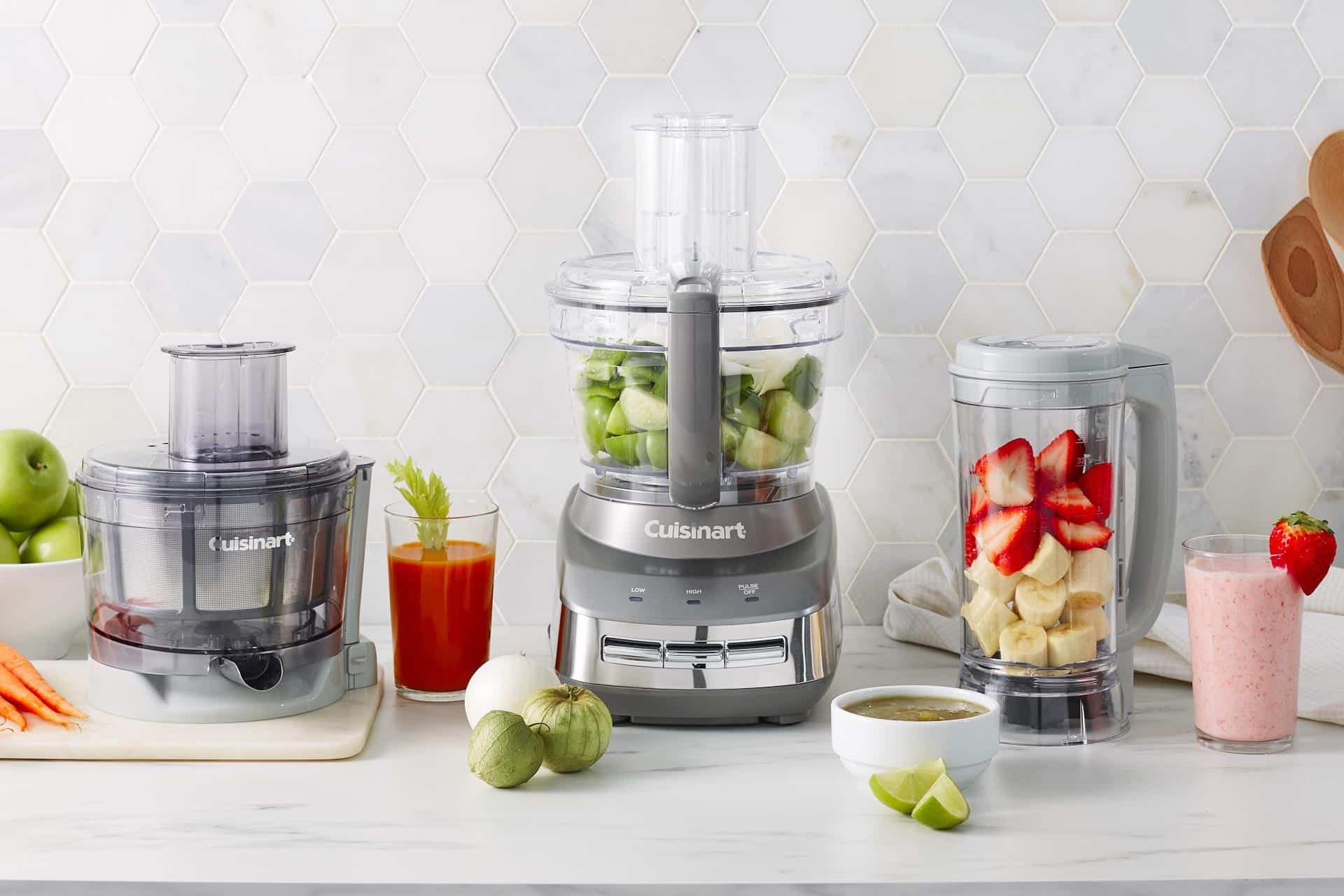Decisions, decisions.


Embarking on culinary adventures in the kitchen often involves more than just a sharp knife and a cutting board. Whether you’re aiming to purée a soup to silky smoothness, chop veggies for a vibrant salad or embark on any task in between, having the right gadget at your disposal can make all the difference. Enter the kitchen’s powerhouse appliances: the blender and the food processor.
While they might seem similar at first glance, each serves its unique purpose, mastering tasks the other can’t. And by understanding the capabilities of these versatile tools, you’ll be equipped to choose the right one for any job, transforming your time in the kitchen into an efficient, enjoyable and creative process.
Let’s take a look at the layers of these culinary companions and discover their top functions, strengths and even when to use one over the other.
Hungry for more? From blenders and food processors to air fryers, slow cookers and more, our collection of small appliances has the perfect tool for your next meal.
A blender is primarily designed for tasks involving liquids. It’s your go-to appliance for making smoothies, milkshakes and other liquid concoctions. The blender’s blades are specially designed to create a vortex, pulling ingredients downwards towards the blade to achieve a smooth, consistent texture. This makes it ideal for:
Hand blenders, also known as immersion blenders, bring a unique versatility to the kitchen that stands apart from both traditional blenders and food processors. Their design allows you to blend ingredients directly in the pot, pan or bowl, making them ideal for tasks like creating emulsified sauces, or for small, quick tasks like making a single-serving smoothie or blending a dressing. They’re also an excellent option for those with limited kitchen space, as they’re compact and easy to store.
On the other hand, a food processor is equipped with various blades and disks, making it highly versatile for many types of food preparation tasks that don’t necessarily involve liquids. It’s designed to chop, slice, grate and knead, handling both soft and hard ingredients with precision. Here’s where a food processor shines:
At first glance, blenders and food processors might look capable of doing the same things, but each has its unique strengths thanks to their design. It’s all about the blades, the shape of their bowls and even how powerful their motors are.
At the heart of every blender and food processor is its blade system, which is pivotal in determining the appliance’s effectiveness for specific tasks.
Blenders are equipped with a fixed blade system, usually designed to create a powerful vortex. This motion ensures ingredients are pulled toward the blades, resulting in smooth and evenly blended mixtures. Perfect for liquefying fruits for smoothies or blending soups to a velvety consistency, the blender’s blades are optimized for liquid-based tasks.
Food processors, however, come with a suite of interchangeable blades and disks, each engineered for a specific purpose. From slicing and shredding to chopping and dough kneading, these attachments offer a level of versatility that blenders simply can’t match. This adaptability makes food processors indispensable for tasks requiring precision and variety in texture, such as preparing vegetables for a salad or making pastry dough.
The design of the bowl or container of these appliances significantly affects their functionality. Blenders typically boast a tall, narrow pitcher, ideal for ensuring the ingredients continuously make contact with the blades, thus promoting efficient blending. This shape is particularly beneficial for working with liquids, aiding in the creation of smooth, consistent mixtures without lumps.
Conversely, food processors feature a more spacious, wider bowl designed to accommodate a larger volume of solid ingredients. This shape allows for the easy addition of items and provides ample room for the movement of solid food items across different blades. The broad base is crucial for tasks like chopping vegetables or mixing dough, where ingredients need to be spread out and evenly processed.
The power and speed at which these appliances operate can greatly influence their performance and the outcome of your recipes. Blenders often have high-speed motors designed to crush ice and blend frozen ingredients quickly, necessitating powerful wattage for smooth results. The speed settings are typically fewer but are focused on achieving a thorough blend of ingredients into liquid form.
Food processors, however, are equipped with motors that offer both power and precision. The varied speed settings, including a pulse option, give users control over the texture and fineness of the food being processed. This versatility is essential for handling a wide range of tasks, from gently chopping herbs without turning them to mush to vigorously kneading dough.
Choosing between a blender and a food processor can sometimes be a bit unclear. However, by considering factors such as the desired texture of the final product, the quantity of food you’re working with and the specific requirements of your recipes, you can make an informed decision that enhances your cooking experience. Let’s dive into some situations where you might favor one appliance over the other.
Ultimately, the choice between a blender and a food processor depends on your cooking habits and needs.
If you frequently make smoothies, soups or dressings, a blender might be your best bet. For tasks like slicing vegetables, kneading dough or making nut butters, a food processor will serve you well. And for those who find themselves needing both functionalities regularly, investing in both appliances might be the way to go.
Another critical aspect to consider is the amount of kitchen space you have available. Appliances like full-sized blenders and food processors require a dedicated spot on your countertop or sufficient storage space. Hand blenders, with their compact size, offer a practical alternative for smaller kitchens, easily fitting into a drawer or cabinet without taking up much space.
Budget considerations also can’t be overlooked. Appliance prices vary significantly, and setting a realistic budget that reflects your needs and usage frequency is important. Investing in a durable, reliable brand might seem pricier upfront but can prevent frequent replacements and save money in the long run. The features and attachments that come with the appliance play a significant role in its versatility and value, too. Some models come equipped with a variety of attachments that can perform tasks beyond their basic function, potentially replacing other gadgets in your kitchen.
Finally, consider how easy the appliance is to clean, as ease of maintenance can greatly influence your satisfaction and the appliance’s longevity.
Hungry for more? From blenders and food processors to air fryers, slow cookers and more, our collection of small appliances has the perfect tool for your next meal.
JOIN THE CONVERSATION